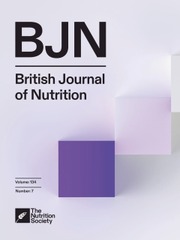No CrossRef data available.
Article contents
Associations between plasma advanced glycation end products levels and body composition parameters: a cross-sectional study in Chinese participants aged over 40 years old
Published online by Cambridge University Press: 19 September 2025
Abstract
To investigate the association between plasma advanced glycation end products (AGEs) level and fat, skeletal muscle related body composition parameters in middle-aged and elderly Chinese participants. A total of 1139 participants aged over 40 years were included in a cross-sectional study. Body composition including body mass index (BMI), waist to hip ratio (WHR), fat mass index (FMI), percentage of body fat (PBF), the ratio of trunk fat to legs fat (trunk fat/legs fat), fat free mass (FFM), fat free mass index (FFMI), and skeletal muscle index (SMI) was measured using a bioelectrical impedance analyzer (BIA). Plasma free and combined AGEs were measured by ultra-high performance liquid chromatography-tandem mass spectrometry (UPLC-MS/MS). Multiple linear regression and weighted quantile sum regression (WQS) models were used to examine the association between AGEs and body composition parameters. Total exposure of plasma AGEs was positively associated with BMI [β (95%CI): 0.381 (0.037,0.724), P=0.030], FMI [β (95%CI): 0.521 (0.241,0.800), P=0.001], PBF [β (95%CI): 1.996 (1.160,2.832), P <0.0001], Trunk Fat/ Legs Fat [β (95%CI): 0.058 (0.036,0.080), P <0.001]; while it was negatively associated with FFM [β (95%CI): -1.075 (-2.028,-0.122), P=0.027], FFMI [β (95%CI): -0.687 (-1.076,-0.297), P=0.001] and SMI [β (95%CI): -1.264 (-1.767,-0.761), P<0.001]. The associations between plasma AGEs and FFM and FFMI were more pronounced in those aged less than 61 years and female participants. This study provides evidence on the associations between plasma AGEs and fat and skeletal muscle parameters, suggesting their potential role in the development of obesity and skeletal muscle loss.
Keywords
Information
- Type
- Research Article
- Information
- Copyright
- © The Author(s), 2025. Published by Cambridge University Press on behalf of The Nutrition Society

